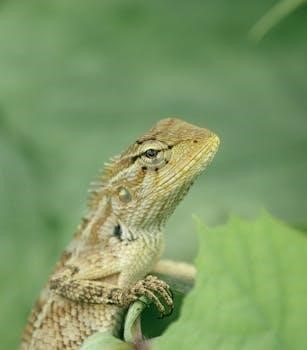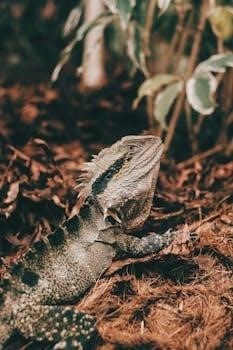
Embark on a comprehensive exploration of bearded dragon dimensions! This guide unveils the intricacies of bearded dragon sizes․ From hatchlings to adults, including species variations, diet impacts, health considerations, and essential husbandry․ Discover how to measure your dragon correctly and understand enclosure size requirements, and other important factors․
Bearded dragons, scientifically known as Pogona, are captivating reptiles․ These creatures have gained immense popularity as pets, celebrated for their docile nature and unique characteristics․ A key aspect for any owner or enthusiast to understand is their size․ This introduction serves as a gateway to exploring the diverse dimensions․
The most common pet species, Pogona vitticeps, exhibits a typical adult size․ However, variations exist across different species․ Factors such as genetics, diet, and environment play crucial roles in determining a dragon’s ultimate length and weight․
Understanding the nuances of bearded dragon size is essential for responsible care․ Proper enclosure size, appropriate feeding strategies, and early detection of potential health issues are all intrinsically linked to a dragon’s growth and development․
This guide will delve into the specifics of bearded dragon size, offering insights into average measurements at various life stages, the impact of external factors, and practical tips for ensuring your scaly companion thrives in optimal condition․ We will cover all you need to know about bearded dragon sizes․
Average Size of Adult Bearded Dragons (Pogona vitticeps)
The inland or central bearded dragon, Pogona vitticeps, is the most common species found in captivity․ Adult Pogona vitticeps typically reach an average length of 18 to 22 inches (45 to 55 cm) from snout to tail tip․ Their tail accounts for more than half of their total length․
In terms of weight, a healthy adult bearded dragon usually weighs between 350 to 600 grams․ Males tend to be slightly larger and heavier than females, but there can be individual variations․ The length and weight can be influenced by factors such as genetics, diet, and overall health․ A well-cared-for bearded dragon with proper nutrition and a suitable environment will likely reach its full potential size․
It’s important to note that captive bearded dragons can sometimes become obese․ This is usually due to overfeeding and lack of exercise․ Regular monitoring of your dragon’s size and weight is crucial․
Understanding the average size of adult Pogona vitticeps provides a baseline for assessing your dragon’s growth and ensuring they receive appropriate care․
Bearded Dragon Growth Chart⁚ Age vs․ Size
Understanding your bearded dragon’s growth rate is essential for providing proper care․ This chart offers a general guideline, but individual growth can vary based on genetics, diet, and environment․
Hatchlings (0-2 months)⁚ At this stage, bearded dragons are typically around 2-3 inches long and weigh approximately 4-6 grams․ They grow rapidly, requiring frequent feedings of small insects․
Babies (1-3 months)⁚ During this period, they grow from 3 to 9 inches in length and weigh between 4-20 grams․ Provide a diet rich in protein to support their growth․
Juveniles (3-11 months)⁚ Juveniles experience significant growth, reaching lengths of 8-24 inches․ Their weight increases considerably․ A balanced diet of insects and vegetables is crucial during this phase․
Sub-Adults (11-18 months)⁚ Growth begins to slow down as they approach adult size․ They will be more like 18 to 24 inches long․
Adults (18+ months)⁚ Once they reach 18 months or older, bearded dragons are considered adults․ This is when they reach their full size, generally between 18-22 inches․

Factors Affecting Bearded Dragon Size
Several factors influence a bearded dragon’s final size․ Genetics play a significant role, with some dragons naturally growing larger than others․ The species or morph of your bearded dragon can also contribute to its potential size․
Diet is another crucial element․ A well-balanced diet, rich in essential nutrients, supports healthy growth, while a poor diet can stunt growth and lead to health problems․
Proper lighting and temperature are also vital․ Adequate UVB lighting helps dragons metabolize calcium, essential for bone growth․ Inadequate temperatures can affect their metabolism and overall development․
The size of the enclosure can also impact a bearded dragon’s growth․ A small enclosure may restrict movement and hinder growth․ Regular handling and exercise can promote muscle development and overall health․
Underlying health conditions can also affect growth․ Parasites or illnesses can interfere with nutrient absorption, leading to stunted growth․ Regular veterinary check-ups are essential for early detection and treatment․
Enclosure Size Requirements Based on Age

Selecting the right enclosure size is crucial for a bearded dragon’s well-being at different life stages․ Hatchlings and juveniles, up to 3 months old, can thrive in a 20-gallon tank․ This provides enough space for movement while maintaining proper temperature gradients․
As they grow, juveniles between 3 and 11 months require larger enclosures․ A 40-gallon breeder tank is ideal, offering ample room for exploration and basking․ Sub-adults, from 11 months to around 1 year, need at least a 75-gallon tank to accommodate their increasing size․
Adult bearded dragons need even larger enclosures․ A 120-gallon tank is the recommended minimum size․ This provides enough space for them to move freely, exhibit natural behaviors, and maintain a comfortable temperature gradient․
The enclosure should be at least 4 feet long, 2 feet wide, and 2 feet high․ Remember, providing a larger enclosure is always better, as it promotes activity and reduces stress․ Adequate ventilation is also essential for maintaining air quality and preventing respiratory infections․
Measuring Your Bearded Dragon

Accurately measuring your bearded dragon is essential for monitoring growth and overall health․ The standard measurement is taken from the snout to the tip of the tail․ Use a flexible measuring tape for the most accurate reading․ Gently restrain your bearded dragon to minimize stress during the process․
Start by placing the end of the tape measure at the tip of the snout․ Extend the tape along the body, following the natural curve, to the very end of the tail․ Record the measurement in inches or centimeters․ Regular measurements, taken monthly, can help track your dragon’s growth rate․
Weight is another important metric․ Use a kitchen scale to weigh your bearded dragon in grams or ounces․ Place your dragon in a small container on the scale and record the weight․ A sudden increase or decrease in weight, combined with size measurements, can indicate potential health issues․
Consistency is key․ Always measure your bearded dragon at the same time of day and under similar conditions for reliable data․ Keep a record of measurements to identify any deviations from the expected growth pattern․
Differences in Size Between Male and Female Bearded Dragons
While both male and female bearded dragons (Pogona vitticeps) typically reach similar lengths, subtle differences in size and build can often distinguish them․ Males tend to have slightly larger heads and a broader build compared to females․ This is often more noticeable as they reach adulthood․
Females, on the other hand, may appear wider in the body, especially during breeding seasons․ This is due to the development of eggs․ However, overall length is generally comparable between the sexes, with both reaching approximately 18 to 22 inches when fully grown․ The tail length makes up a significant portion of their total length․

Beyond size, other physical characteristics can help differentiate males and females․ Males typically have larger femoral pores located on the underside of their thighs, which are more prominent and secrete a waxy substance․ They also exhibit more pronounced hemipenal bulges at the base of their tail, which are visible upon closer inspection․ These bulges are due to the presence of hemipenes, the male reproductive organs․
Behavioral differences can also provide clues․ Males often display more territorial behavior, including head bobbing and beard displays, especially during mating season․
Size Variations Among Different Bearded Dragon Species
While the inland bearded dragon (Pogona vitticeps) is the most common pet species, several other bearded dragon species exist, exhibiting noticeable size variations․ Understanding these differences is crucial for providing appropriate care․
The Rankin’s bearded dragon (Pogona henrylawsoni), also known as the pygmy bearded dragon, is significantly smaller than the inland species, typically reaching only 10 to 12 inches in length․ This compact size makes them suitable for smaller enclosures․
Conversely, other species like the Drysdale River bearded dragon and the Kimberley bearded dragon can also vary in size, though they are less commonly kept as pets․ These species may reach lengths slightly shorter than or similar to the inland bearded dragon․
The central and eastern bearded dragons are among the largest, with some individuals potentially exceeding 24 inches․ Their larger size necessitates more spacious enclosures to accommodate their activity levels and ensure their well-being․
These size variations highlight the importance of correctly identifying the species of your bearded dragon to provide appropriate care and housing․ Factors such as genetics, diet, and overall health also play a role in determining an individual’s final size․
Potential Health Issues Related to Size
Bearded dragon size is not merely a matter of aesthetics; it can also be indicative of underlying health concerns․ Both stunted growth and excessive size can signal potential problems that require attention․
Stunted growth, where a bearded dragon fails to reach its expected size for its age, can be caused by factors such as inadequate nutrition, insufficient UVB lighting, or parasitic infections․ These deficiencies can hinder proper bone development and overall growth․
Conversely, rapid or excessive growth can also be problematic․ Overfeeding, particularly with high-fat foods, can lead to obesity, which can strain the bearded dragon‘s organs and joints․ Obese bearded dragons may also be prone to fatty liver disease and other metabolic disorders․
Metabolic bone disease (MBD) is another potential issue related to size and growth․ It results from a calcium deficiency, often caused by inadequate UVB exposure or improper calcium supplementation․ MBD can lead to weakened bones, deformities, and stunted growth․
Regular monitoring of your bearded dragon‘s size and weight, along with veterinary check-ups, can help detect these health issues early on; Addressing nutritional deficiencies, providing proper lighting, and managing weight can help ensure your bearded dragon maintains a healthy size and enjoys a long, active life․
Understanding the Impact of Diet on Size and Growth
A bearded dragon‘s diet plays a pivotal role in its size and growth trajectory․ Providing the right balance of nutrients is crucial for healthy development from hatchling to adult․
Hatchlings and juveniles require a diet rich in protein to support rapid growth․ This primarily comes from insects like crickets, dubia roaches, and mealworms․ As they mature, the proportion of insects in their diet should decrease, while the amount of plant-based food increases․
Adult bearded dragons need a diet that is approximately 80% plant-based and 20% insect-based․ Leafy greens such as collard greens, mustard greens, and dandelion greens should form the foundation of their vegetable intake․ Avoid spinach and other foods high in oxalates, which can interfere with calcium absorption․
The quantity and frequency of feeding also influence size and growth․ Overfeeding can lead to obesity, while underfeeding can result in stunted growth and nutritional deficiencies․ It’s important to monitor your bearded dragon‘s weight and adjust their food intake accordingly․
Calcium and vitamin D3 supplementation is essential, particularly for young, growing bearded dragons․ These nutrients are crucial for bone development and preventing metabolic bone disease․ A varied and balanced diet, combined with appropriate supplementation, will help ensure your bearded dragon achieves its optimal size and maintains good health․